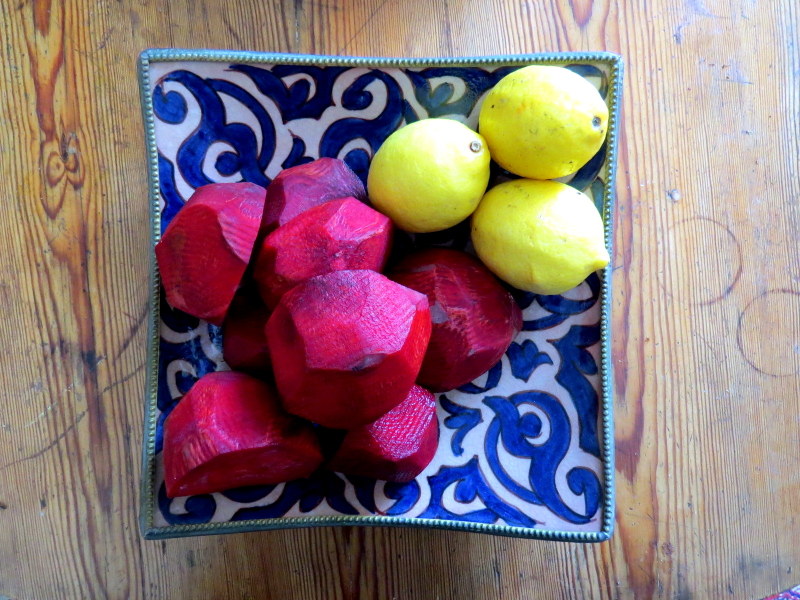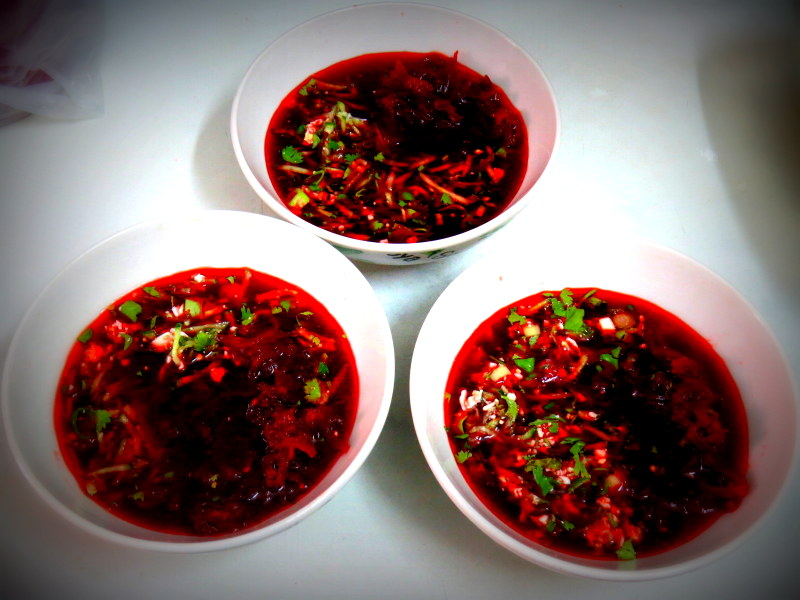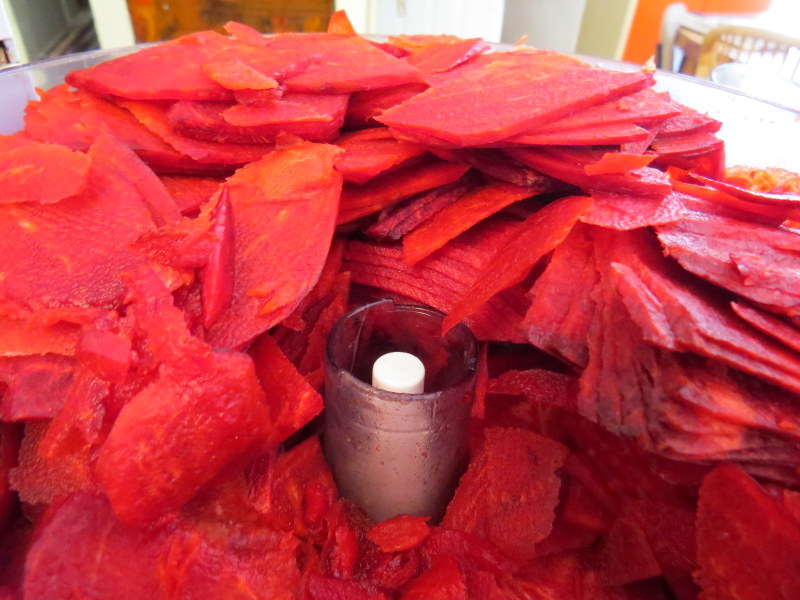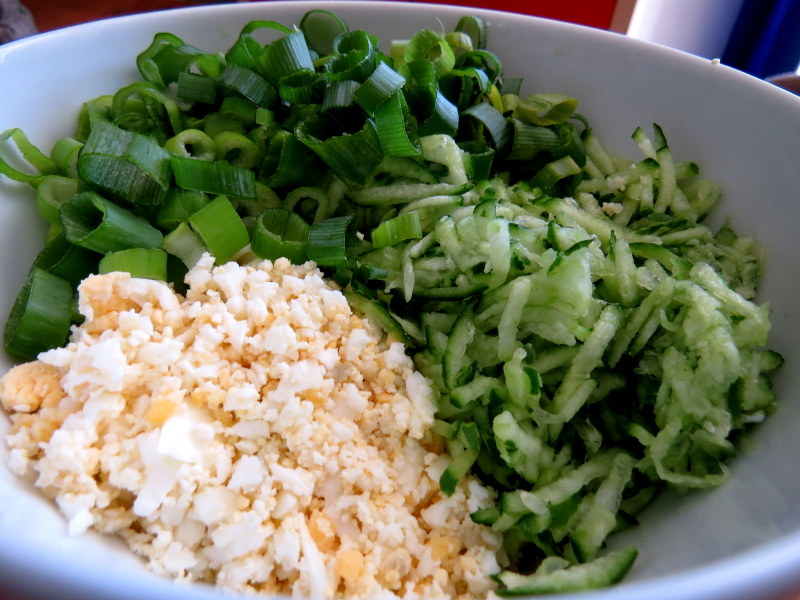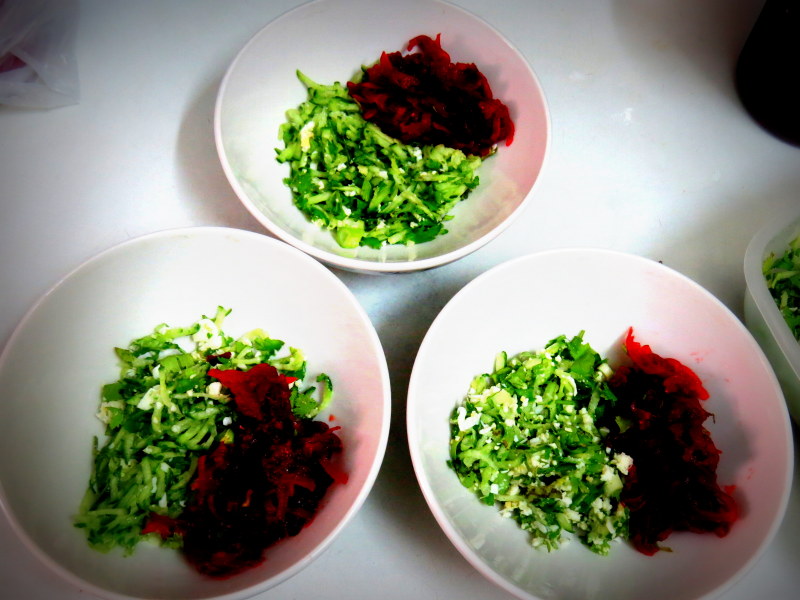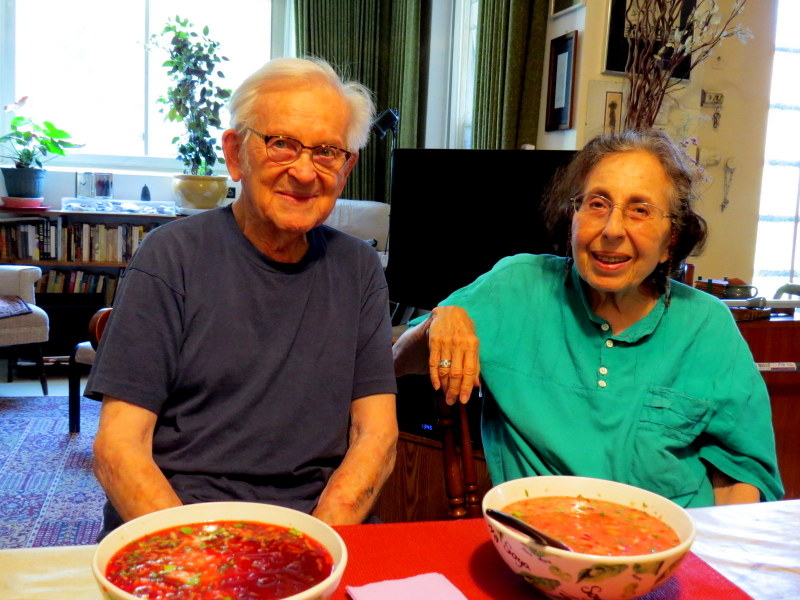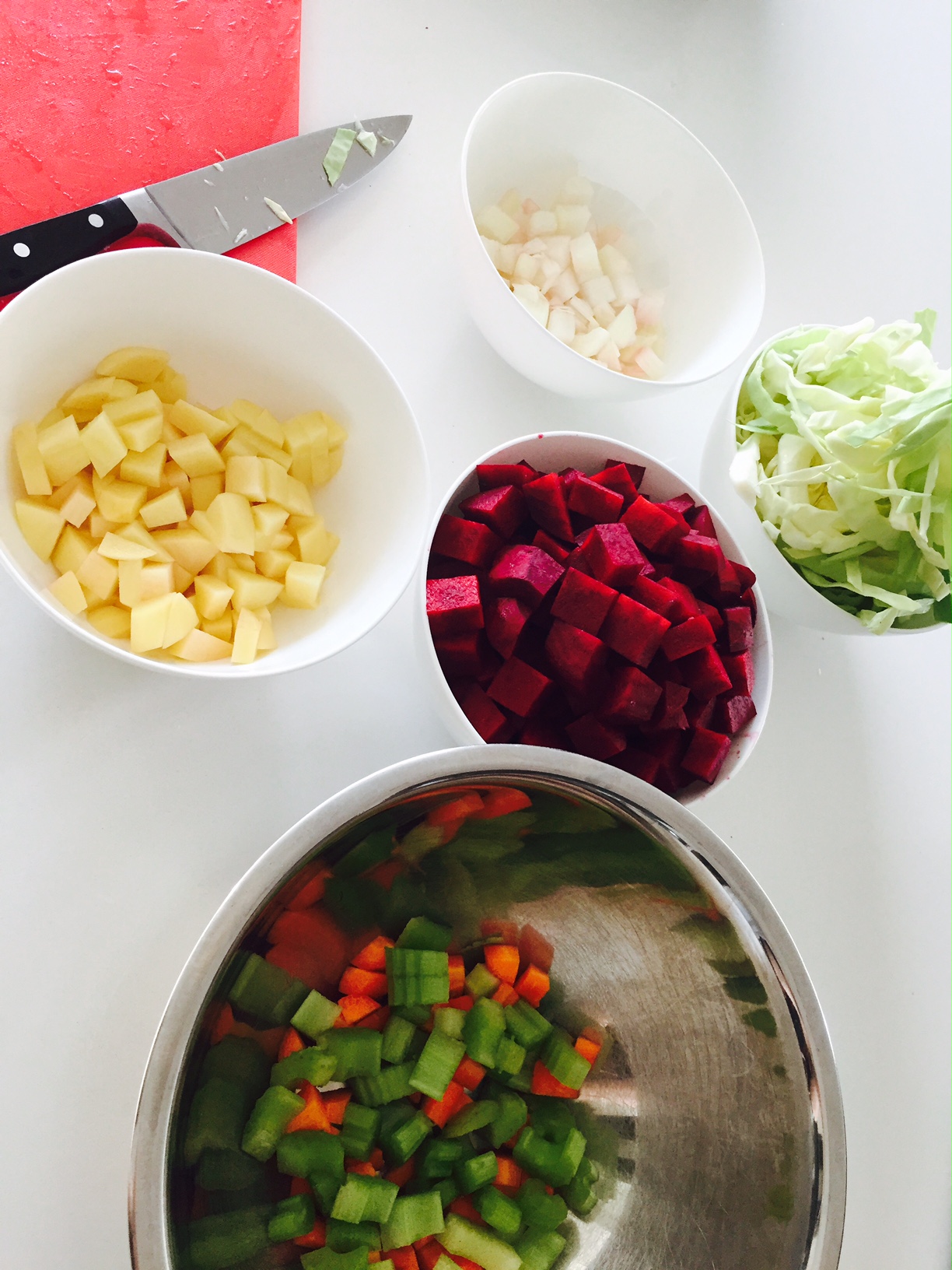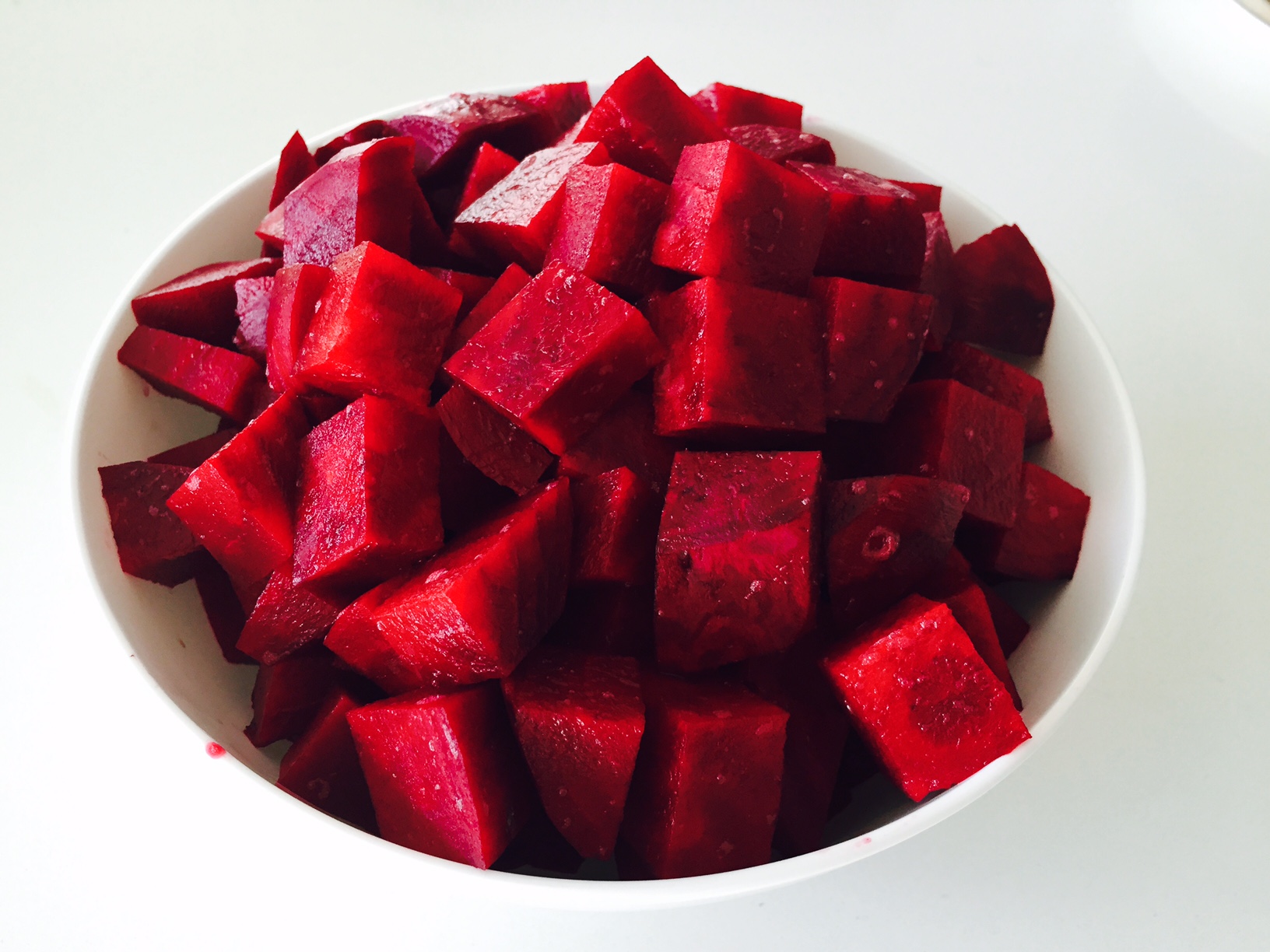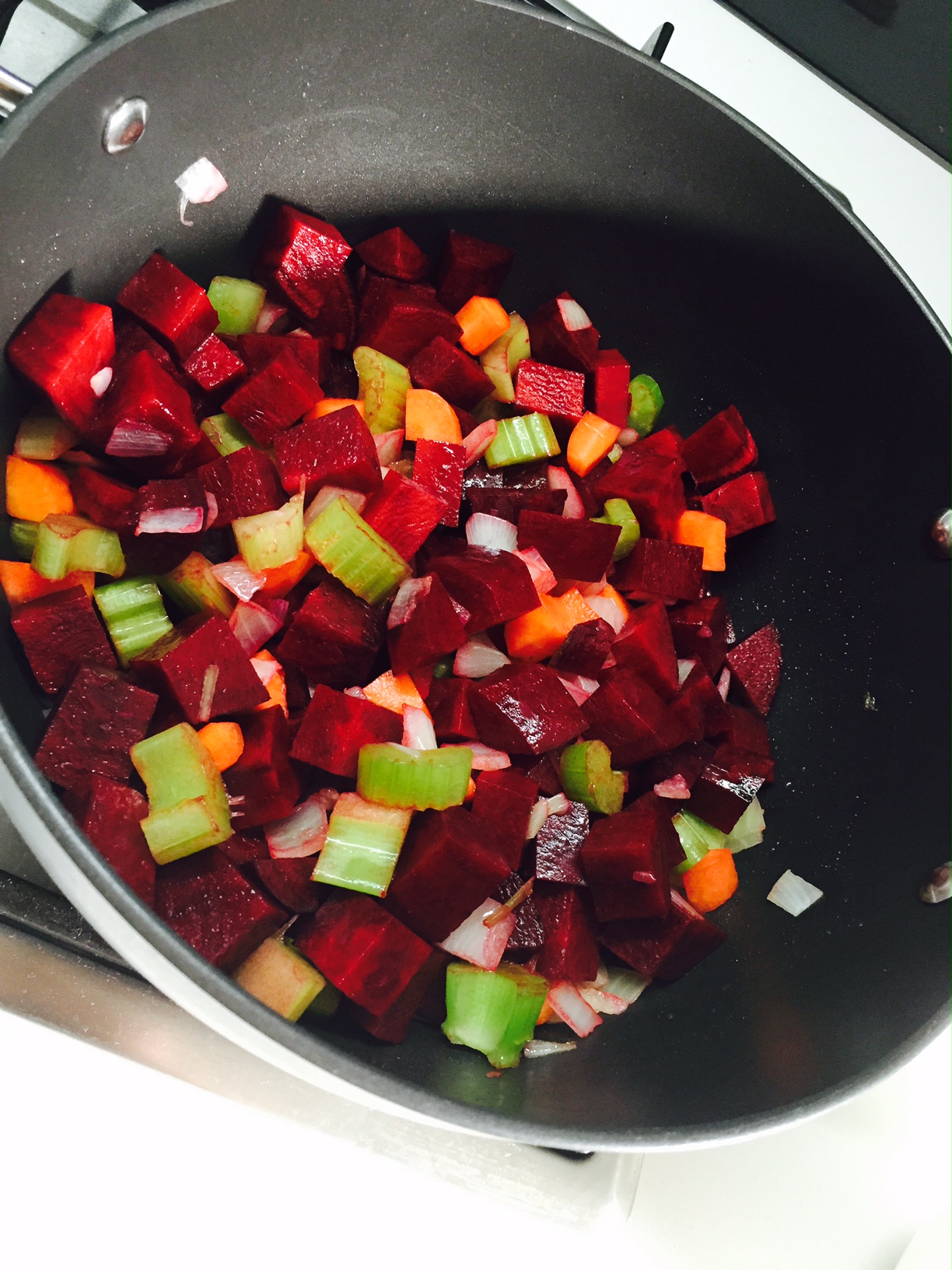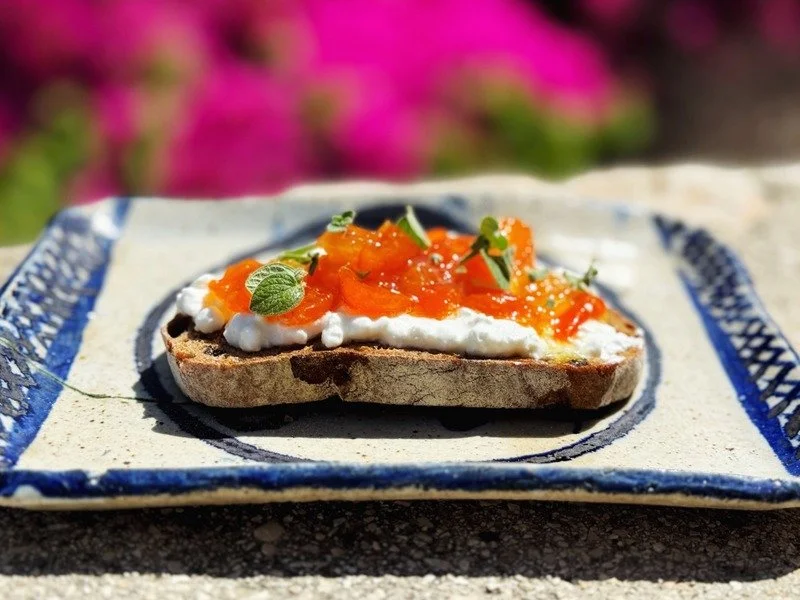Beetroot
When I was growing up, beetroot was not all that popular. It was only available tinned in Australia – at least I never saw it fresh then – and I remember religiously fishing it out of hamburgers and salad sandwiches.
But it’s since undergone a renaissance, reinvented as a red superfood. Low in calories, packed full of vitamins and minerals, it can lower blood pressure, increase stamina, fight cancer – you know, the usual drill… and now we've discovered the joys of roasting fresh beetroot as well as juicing it.
This week, we’re going back to basics, with a recipe our grandmothers have been eating for decades: Borscht. It’s a beetroot soup that comes in summer and winter versions. Very useful when some of your test kitchens are sweating it out in a sweltering summer, whilst the others are still shivering in mid-winter.
Borscht
Borscht is a classic Russian Jewish soup – really, a classic Russian, Ukrainian, Polish, Baltic, Scandinavian soup; your life could be in danger if you choose among these competing claims as to who originated it!
This is the recipe of one of our Food is Love grandmothers – in fact great grandmother! - Ruth Hampel.
Ruth Hampel
Ruth who now lives in Melbourne, where she brought up her 3 sons. She herself was born in Germany and brought up in Russia.
Ruth Hampel with her 3 sons, Max, Alex and Danny
Her parents took baby Ruth to Communist Russia when they went there to work in 1930. As a result, Ruth is one of the increasingly small set of people who remember first hand what it was like to live in Stalin’s Russia.
RUSSIA UNDER STALIN
Ruth remembers people suffering well before World War Two began. The 1930's was a time of arbitrary arrests for imagined crimes across the Soviet Union. People were declared Enemies of the People and disappeared. You could wait years to find out the fate of loved ones who had been imprisoned in Soviet labour camps – or shot.
Although Ruth was a child, she was also affected. When she was seven, her parents were arrested. Her great good fortune was that a loving aunt took her in, saving her from the fate of thousands of other children like her - being sent to a state orphanage. The Soviets detained so many 'Enemies', they had to build extra orphanages.
KGB
But officers from Russia's secret police, the KGB, kept tabs on Ruth even after her mother's arrest. She remembers at 9 years old, 2 KGB officers coming to the yard where she was playing near her aunt’s Moscow home, to try to talk her into leaving with them.
“Come with us! Do your aunt and uncle feed you? Do they beat you?”
She ran home, but she knew they were always watching her. Which was the point of the excercise, since after all they could have taken her by force if they'd wanted to.
In 1941 Germany attacked Russia, bringing the Soviet Union into World War Two.
There was real panic in Russia as German troops closed in on Moscow. Civilians were being evacuated from the Russian capital, including Ruth and her family. Just as she was about to leave, two KGB officers approached her.
She was 11 years old.
“Hello Ruth!”
“Where are you going?”
“To Kamchatka, with my mother,” Ruth replied.
“Why are you going to Kamchatka to your mother, she’s a traitor?”
“But my aunt and uncle have adopted me, I’m not going to my mother, I’m going with my new mother.”
They let her go. But that was how nimble Ruth had to be around authority figures, aged only 11.
“And that’s what the KGB had to do with their time when the Germans were at the gates of Moscow,” says Ruth now.
MOTHER
Ruth was ultimately reunited with her mother – but not her father – a story we will tell in full in later posts. The account of their survival during the War, and their escape from Russia when the War ended, travelling West for months across the length of the vast, bombed out, lawless country in ruins is worthy of a film.
Ruth is an excellent cook and still prepares Russian dishes for herself and her family – including her mother's wonderful strawberry tart, which she now makes gluten-free for her grandchildren, and this beetroot soup.
Cooking: to roast or not to roast?
The big question for both the hot and cold soups is whether to throw the beets into the soup as is or to roast them first. Ruth prefers roasting, but she says that there is no one definitive recipe.
"From village to village across Russia borscht was done differently, just like minestrone in Italy!"
Summer
The cold summer borscht is known as Svekolnik, from the Russian word for beetroot, is basically a salad of greens and hard-boiled eggs, with red lemony beetroot broth poured over the top, and yoghurt/buttermilk/sour cream added at the end. It is a great summer dish, light, refreshing and healthy.
I like this recipe, because you make a broth with some of the beets and roast others to add at the end.
You make the stock one day ahead and let the flavour improve in the fridge. But since it’s a cold soup, it’s very quick to assemble after that.
Cold Beetroot Soup (Svekolnik)
Serves 4
Ingredients
For the broth:
- 4 medium-sized beets
- 2 -3 tablespoons cider vinegar or juice of ½ lemon
- 10 cups water or stock
- salt and pepper to taste
For the dish:
- 2 large beets
- 2 hard-boiled eggs grated
- 5 cucumbers, grated
- ½ cup chopped shallots or chives
- ½ cup chopped dill or other herbs [I used coriander]
- optional: one teaspoon horseradish
- ½ lemon
- Kefir or buttermilk
- Optional: Additional sour cream for serving
Method
1. Preheat the oven to 200 degrees.
2. Clean and trim the beets. You are roasting 2 of them, and using the other 4 to make stock. Take the 2 which you are roasting, peel and drizzle with vegetable oil, sprinkle with salt and wrap in aluminium foil. Roast in a medium oven until tender, about 1 hour. They are ready when a knife goes in easily. Cool in the fridge in the foil, until you are ready to grate into the soup the following day.
3. Peel and shred / thinly slice the remaining 4 beets. These will not be in the final dish so use whichever method is easiest for you. I do it in the food processor as it takes almost no time, plus your hands don't get stained.
4. Bring stock or water to the boil, add one teaspoon salt and the chopped beets. Squeeze in the juice of half a lemon, or 2 tablespoons of vinegar. Cover, reduce heat and let simmer for 1 hour. Your basic broth needs to be quite sour. When it’s ready, let it cool, and then chill in the refrigerator overnight. You can also make some extra stock by boiling up the beetroot skins, and the remains of the onions and herbs. In the spirit of World War Two, waste not, want not!
5. When ready to serve, strain the soup. You will not need the boiled beets for this dish. Taste and adjust the seasonings. Add more lemon juice, and horseradish, if using. I like it salty and lemony.
6. Now your food processor can get a work out. Shred the cucumber, the egg and the peeled roasted beets. (Do the beets last!) Chop up the shallots or chives.
7. Squeeze some liquid out of the cucumbers, and make a salad adding it to the eggs and the greens. Keep these ingredients separate from the stock until you serve.
8. Prepare your soup: In each bowl, add 2-3 table spoons (or more if you like) of your salad mixture, add the grated roast beets and your beet broth. Garnish with buttermilk and/or sour cream.
Jerusalem test kitchen
The soup is easy to make. Preparing the beet stock 24 hours early so that the flavours improve is not hard, it’s just about planning. The result was lovely, light and healthy. I didn't need sour cream. The buttermilk – or Russian kefir if you can find some – was enough for me!
I took some over to the home of dear friends Yehuda and Leah Bacon. He is an artist and a Holocaust survivor. He survived Teresiendstadt and a long period in Auschwitz - a story in itself. Yehuda has a precise and detailed memory for the extraordinary things he has endured and witnessed during his life time, as well as a wonderful overview. It's what you'd call wisdom.
We all enjoyed this summer soup. Ruth Hampel says that when she eats the cold version, she always has it with potato latkes – and it’s her favourite meal. Yehuda and Leah and I could see why!
Winter
The classic winter soup can include meat stock and bones, or pieces of meat - Ruth makes hers with osso bucco veal – or it can also be vegetarian. (Russians, Poles and Ukrainians make a vegetarian version during the Lenten fast.) If you keep a kosher kitchen and you want to add butermilk or sour cream at the end, you will obviously make the vegetarian version.
I'm sidestepping the whole question of whether or not to use kvass, a Russian fermented cider, by simply deciding not to -- cider vinegar is a good enough substitute. But I am including bay leaves, tomato paste and allspice as options, since they are classic ingredients, even though Ruth leaves them out of her version.
Beetroot Borscht
Serves 4
Ruth roasts her beets before adding them to the pot, which she believes produces a tastier result. I am also including a quick no-roast option at the end, for those days you don’t have time for extra steps.
Ingredients
- 4 medium beetroot, peeled (450 g beetroot)
- 1 small onion, 1 small carrot, 1 stick of celery, 1 small leek, all peeled and chopped
- 1.5 litres / 6 cups liquid. Beef stock is the classic - but you can use turkey or chicken or vege stock, or even water
- ½ small cabbage, shredded or ½ kilo sauerkraut
- 4 cloves garlic, peeled and crushed
- 2 tablespoons cider vinegar
- ½ teaspoon ground black pepper
- 2 whole allspice seeds
- 1 bay leaf
- OPTIONAL:
- ½ kilo veal ie 3-4 slices
- one tin of beans – red kidney beans, or white beans
- 2 large tablespoons tomato paste
To serve: Sour cream and fresh dill and 3 boiled potatoes.
Method
1. Wash and scrub the beets. Don’t cut the tops off completely, leave about 2 cm. Wrap each beet in foil and bake in a slow preheated oven (about 160 C) for 1 hour. As they get softer you can turn the heat down to 150 C. When they are cool, peel and dice or grate.
2. Melt 2 tablespoons oil or butter in a large pan. Cook the onion over a low heat for 5 minutes
3. Add the carrot, leek, celery and stir well to coat. Cook for another 10 minutes, adding tomato paste - if using - and a little stock when the vegetables begin to look dry
4. Add the roasted beets and pour in the rest of the stock. Now is the time to add the bay leaf and allspice, if using, while you let the soup simmer for 15 minutes
5. If you are using meat in the soup, quickly pan fry, and throw it into the soup pot with the juices. You can leave it as is if you want it for flavouring. If you want to serve the soup with small pieces of meat in each bowl, cut it up before adding it to the pot.
6. Add the cabbage, or saurerkraut and tinned beans. Add 3 of the crushed garlic cloves - reserve a little for just before serving. Cook for 20-30 mins, till the meat is done. (Cook it longer if you prefer your meat well-done.)
7. Boil the potatoes now so they will be ready when you want to serve the soup.
8. When all the vegetables and meat are tender, add the vinegar, pepper and salt. Taste. Add more of any of these if necessary.
9. Just before serving, add the last portion of the crushed garlic to the hot soup. That’s what my grandmother did, and it really adds something to the flavour.
NB: If you don’t have time to roast the beets first, chop them into small dice, or grate on the thickest blade of your food processor. Put ¾ of the chopped beets into the pan at step 3, along with the other veges, making sure they are well covered with oil before you add the stock. Add the last quarter of the beets when you add the cabbage, at step 5.
Serve with a dollop of sour cream and boiled potatoes, sprinkled with dill, or rye bread.
MELBOURNE TEST KITCHEN
In Melbourne, Amanda Hampel made her husband's grandmother's soup with great pride.
She's not usually a borscht girl, preferring to roast beetroot and put it in a salad - and we will post her roast salad with pomegranates and pistachios soon :-)
First things first, Amanda used gloves for peeling and chopping the beetroot. "They are lifesavers!"
Second, she didn't have time to roast the beets, and followed the second option in the recipe, frying the raw chopped beets with the other vegetables before adding the stock. She loved the result, starting with the delicious smell in her kitchen while she was cooking. She says its the "smell of old Europe." I'd say it's also the smell of Russia!
Her cousin came over for a taste test and her young daughters all LOVED it.
They were sold on the combination of flavours, the sweetness of the beetroot and the other veges, the sharpness of the garlic. Their verdict?
"It's a perfect combination! And it's so warm and makes you feel all warm and cosy."
Then they lapsed into "mmmmmmm's" which Amanda took as a sign of success :-)
Sydney test kitchen
In Sydney, Margo instantly connected to the idea of borscht, and made it the day she received the recipe. She didn't use beans or veal, but did use a homemade turkey stock which had a few chunks of turkey meat in it. She also subbed in cumin seeds (caraway) for allspice. It was a hit in her house that’s for sure.
“My husband called it 'The best borscht you've ever made,' so that's saying something!”


